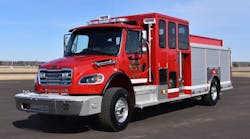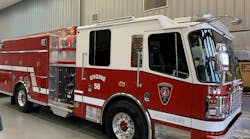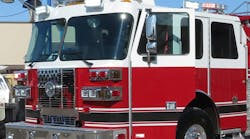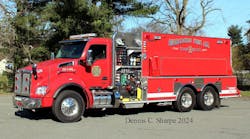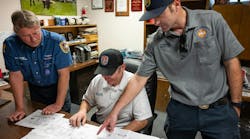If your department is like many and you are replacing a conventional aerial ladder, your committee has probably looked at some type of aerial platform or tower ladder. Either of these units can provide effective ladder company service, providing it meets the needs of the community and fits into the tactical operations of the fire department. Probably one of the biggest sticking points with respect to ladder truck design is whether to include a fire pump into the design of the vehicle. We will not delve into the positive and negative aspects of operating quints, as this will be the subject of another future article. However, introducing a fire pump into the design of the ladder truck can drastically affect the outcome and usefulness of the rig.
First, let’s consider some of the rationale behind providing a major fire pump rated at 1,500 gpm or more on an aerial device. The fire pump can be utilized to provide water for master stream operations for the aerial without having to tie up another pumper on the fireground. Properly designed aerial waterways can easily provide elevated master streams of 1,000 gpm and greater, depending on the diameter of the waterway pipes, valve size and plumbing layout. When combined with a small water tank and several pre-connected handlines, the unit can be self-sufficient at an incident until another engine company arrives. A typical fire pump and plumbing will add approximately 1,500 pounds of weight to the vehicle, but more importantly will either increase the chassis wheelbase by 20 to 30 inches or take up space in the body that could be used as a transverse body compartment.
Once you decide to include a fire pump on the apparatus, the next issue to address is whether to include a water tank and hosebed. If a water tank is specified, the National Fire Protection Association (NFPA) 1901 required minimum size is 300 gallons. When combined with a minimum hosebed capacity of 30 cubic feet, the typical quint aerial device will have approximately 40% less storage space for tools and equipment when compared to a non-quint apparatus. In addition, when an aerial apparatus is designed as a quint unit, NFPA 1901 states that only 85 feet of ground ladders are required on the apparatus. As we have stated in previous articles in The Apparatus Architect series, the minimum ground ladder requirements may not meet the needs of your response area and you should carefully determine the ladders needed to cover the buildings in your first-due area. Then make sure that these ground ladder requirements are put into your final specifications.
Another consideration when designing an aerial device with a hosebed for large-diameter hose is how the hose will pay out of the rear body when a supply line is being laid. Some designs require the opening of a rear body door or deploying a chute that extends beyond the rear of the body. Other body designs allow for the supply line to be loaded just above the low side compartments on one side of the body. This provides for easier deployment of the supply line, but does reduce the storage capacity for tools and equipment inside of compartments. Most importantly, the inclusion of a fire pump, water tank and hosebed will restrict the use of two-section extension ladders that are enclosed within the body and generally force you to employ three-section extension ladders that are heavier and more difficult to use on the fireground.
As an example, an aluminum two-section 28-foot extension ladder weighs 114 pounds and is 199 inches long when retracted. A similar three-section ladder weights 145 pounds and is 160 inches long when retracted. While the three-section ladder is shorter, the banking thickness and width are both greater than the two-section ladder. Most manufacturers refer to the review of fire pump, tank, hosebed and ground ladders as “packaging the body.” This is one area where you need to make sure that the inclusion of one component does not adversely affect another when developing your specifications.
We recently attended a multi-unit drill with a fire department where they were developing a pre-plan for a large garden apartment complex within its first-due response area. The box alarm card called for the response of three engines, one truck, a squad and a rapid intervention team unit on the first alarm. As the drill unfolded, the first-due company arrived with a 75-foot quint that positioned within one of the buildings in the complex. During the evolution, the quint was properly positioned with both attack lines and ground ladders being deployed by the members.
As the other engines and truck company arrived, it became apparent that there were some problems that had not been previously considered. However, since this was a training session, it was best to uncover these situations before any real damage could be done. The building was a three-story structure and because of building setback from the parking lot, the 75-foot ladder did not have sufficient reach to make the roof. Even after repositioning the rig, it became apparent that the 75-foot ladder was useless at this building.
As ground ladders were being deployed, the quint had only one extension ladder that could make the third floor on the building. The truck company that had staged out on the roadway had numerous ladders that could make any point on the building. It became apparent rather quickly that the first-due company needed to rethink the positioning and use of the its quint at least within this complex.
Once the pre-plan was drafted, the response pattern was changed to place an engine company first due with consideration to always leave room for the responding truck company to position as close to the structure as possible for use of the both the aerial device and the ground ladders. The quint was assigned to take the rear of the building, where closer access was possible with the smaller unit. The moral of this story: Find out what your apparatus and equipment limitations are before you actually need to deploy and use your resources at any incident.
In the next installment of The Apparatus Architect, we will discuss tool and equipment layouts on ladder company apparatus and how they can improve your department’s operations.
Tom Shand will present “Maximizing Your Engine Company” and Michael Wilbur will present “Emergency Vehicle Operations” at Firehouse Expo 2004 in Baltimore, July 13-18.Tom Shand is a firefighter with the Newton-Abbott Volunteer Fire Department in the Town of Hamburg, NY, and a senior instructor at the Onondaga County Community College Public Safety Training Center. He is employed by American LaFrance and is assigned to the Hamburg Facility in the apparatus sales department. Michael Wilbur, a Firehouse® contributing editor, is a lieutenant in the New York City Fire Department, assigned to Ladder Company 27 in the Bronx, and has served for the past five years on the FDNY Apparatus Purchasing Committee. He has consulted on a variety of apparatus related issues throughout the country. For further information, access his website at www.emergencyvehicleresponse.com.




